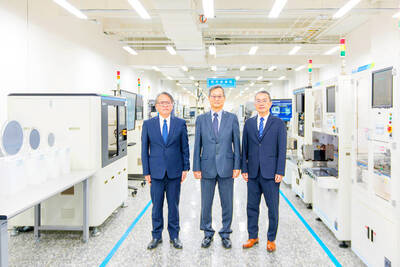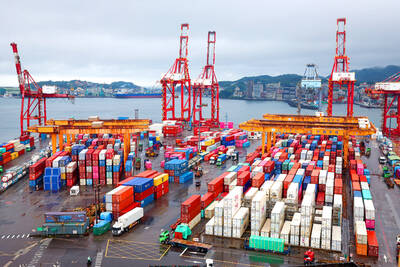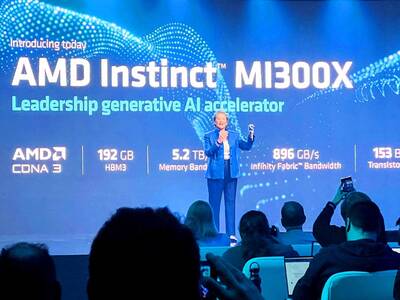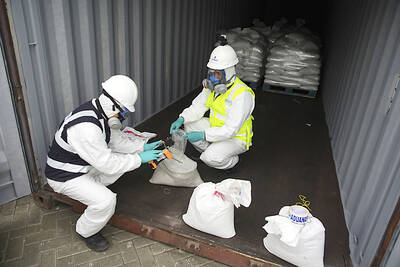A plan to merge Japan’s two biggest stock exchanges has won regulatory approval, the bourses said yesterday, as Tokyo and Osaka team up amid stiff competition from overseas rivals.
The Tokyo Stock Exchange said it had received the green light from Japan’s Fair Trade Commission for its planned takeover of the smaller Osaka Securities Exchange.
The deal was expected to be completed next month, and the two bourses aimed to formally join their operations early next year, Japanese reports said.
The move comes amid an increasingly competitive landscape, with slowing growth and a strong yen taking a toll on the once red-hot Japanese market.
The benchmark Nikkei index at the Tokyo Stock Exchange, which peaked in the late 1980s near the 39,000 level, closed at 9,079.80 yesterday, less than a quarter of its December 1989 value.
The merger would create the world’s third-largest bourse behind leader NYSE Euronext and NASDAQ OMX Group.
The bourses hope that combining Tokyo, the center of share trading in Japan with leading names — including Toyota and Sony — and the derivatives trading focused Osaka bourse will save costs and boost Japan’s securities market.
Singapore and Hong Kong have emerged as key regional rivals, with Hong Kong leading the world’s market for initial public offerings (IPO) over the past few years. The Malaysian exchange is tipped to be Asia’s top IPO market this year, as it plays host to a pair of huge listings this year.
However, some mergers — such as a plan to join the London and Toronto exchanges — have been shut down largely on competition worries or shareholder disapproval.

SMART MANUFACTURING: The company aims to have its production close to the market end, but attracting investment is still a challenge, the firm’s president said Delta Electronics Inc (台達電) yesterday said its long-term global production plan would stay unchanged amid geopolitical and tariff policy uncertainties, citing its diversified global deployment. With operations in Taiwan, Thailand, China, India, Europe and the US, Delta follows a “produce at the market end” strategy and bases its production on customer demand, with major site plans unchanged, Delta president Simon Chang (張訓海) said on the sidelines of a company event yesterday. Thailand would remain Delta’s second headquarters, as stated in its first-quarter earnings conference, with its plant there adopting a full smart manufacturing system, Chang said. Thailand is the firm’s second-largest overseas

‘REMARKABLE SHOWING’: The economy likely grew 5 percent in the first half of the year, although it would likely taper off significantly, TIER economist Gordon Sun said The Taiwan Institute of Economic Research (TIER) yesterday raised Taiwan’s GDP growth forecast for this year to 3.02 percent, citing robust export-driven expansion in the first half that is likely to give way to a notable slowdown later in the year as the front-loading of global shipments fades. The revised projection marks an upward adjustment of 0.11 percentage points from April’s estimate, driven by a surge in exports and corporate inventory buildup ahead of possible US tariff hikes, TIER economist Gordon Sun (孫明德) told a news conference in Taipei. Taiwan’s economy likely grew more than 5 percent in the first six months

SUPPLY RESILIENCE: The extra expense would be worth it, as the US firm is diversifying chip sourcing to avert disruptions similar to the one during the pandemic, the CEO said Advanced Micro Devices Inc (AMD) chief executive officer Lisa Su (蘇姿丰) on Wednesday said that the chips her company gets from supplier Taiwan Semiconductor Manufacturing Co (TSMC, 台積電) would cost more when they are produced in TSMC’s Arizona facilities. Compared with similar parts from factories in Taiwan, the US chips would be “more than 5 percent, but less than 20 percent” in terms of higher costs, she said at an artificial intelligence (AI) event in Washington. AMD expects its first chips from TSMC’s Arizona facilities by the end of the year, Su said. The extra expense is worth it, because the company is

The seizure of one of the largest known mercury shipments in history, moving from mines in Mexico to illegal Amazon gold mining zones, exposes the wide use of the toxic metal in the rainforest, according to authorities. Peru’s customs agency, SUNAT, found 4 tonnes of illegal mercury in Lima’s port district of Callao, according to a report by the non-profit Environmental Investigations Agency (EIA). “This SUNAT intervention has prevented this chemical from having a serious impact on people’s health and the environment, as can be seen in several areas of the country devastated by the illegal use of mercury and illicit activities,”